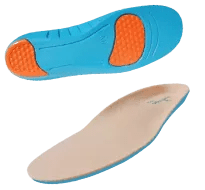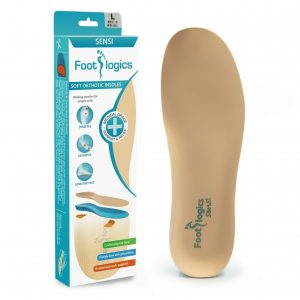Diabetic Foot



Orthotic insoles for people with Diabetes
The Diabetic Foot – how orthotics help...
If you’re someone who lives with Diabetes, you know that proper foot care is critical. Diabetics often suffer from poor circulation and the loss of feeling in their extremities – most commonly in their feet.
Throughout the course of the diabetic process, neuropathy can lead to sensory difficulties. Poor shoe fit, excessive pressure and friction, and even full-blown injuries often go undetected. The result is infection, skin ulcerations and finally, amputation in some cases.
Footlogics offers a solution to excess pressure and friction in the shoe with our soft and cushioning Sensi insoles.
The importance of proper shoe fit
To avoid friction, stress and pressure sores, you must have shoes that fit properly. For optimal support, make sure your shoe matches the length and width of your foot and that it provides an appropriate heel counter. Confirm that there aren’t any obtrusive seams or stitching inside because this will cause rubbing and chafing against your foot.
Orthotic Insoles
You will not require any customized diabetic footwear but a diabetic insole that can be fitted into your shoes to prevent foot conditions from worsening or developing from the start. Yes, these products focus more on prevention and can save hundreds of your dollars.
Foot orthotics help to avoid pressure sores from developing as a result of friction inside the shoe. One of the most common foot conditions that causes friction and pressure is over-pronation.
An over-pronating foot eventually leads to poor foot function and friction under the ball of the foot, on the outer edge of the big toe joint and on top of any of the five toe joints.
Diabetic foot care
Use these helpful suggestions to keep your feet safe:
- Examine your feet every day
- Seek indications of cuts, blisters, discolouration, sores, and swelling (if necessary, use a mirror to inspect the bottoms of your feet)
- Maintain a clean foot bath (use warm, not hot, water and a mildly concentrated soap; be careful to dry, especially in between your toes)
- Use lotion on regions of dry skin, but never between your toes (use foot powder there instead)
- Make clean cuts across the top of your toenails and keep them clipped (see a podiatrist for advice).
- replace your stockings or socks each day
- the best socks are seamless and fitting; stay away from tight elastics
For more information and helpful tips, please visit the Canadian Diabetes Association
Footlogics Sensi – the right orthotic for Diabetes
Footlogics Sensi Diabetic Orthotic Insoles help to evenly distribute your body weight over the entire surface of your foot. This is a “full contact” insole with a footbed that ensures proper biomechanical gait, which reduces and prevents excess friction from occurring.
Footlogics Diabetic Orthotics are made of a cushioning PU Gel that moulds to the shape of your foot after just a few days of regular wear. To add comfort as you walk and minimize shearing, chafing and friction, the top layer of the orthotic is made of soft Plastazote. It is important to note that although they have proved to be quite helpful to many people who suffer from Diabetes, you should consult with your doctor prior to purchasing a pair of diabetic orthotics.
Orthotics supports your feet and works to align them back into their natural position. The medical-grade Plastazote© top layer prevents any kind of allergies and also provides maximum cushioning.
Many people with diabetes consider ‘Footlogics Sensi’ the ideal footbed for their ailing feet as it also provides excellent comfort while walking for people stricken with arthritis and sensitive feet.

